Prof. Ralph Müller
Exploring the Mechanoregulation of Bone Regeneration

In over 100 years, the remarkable ability of bone to adapt to its mechanical environment has been a source of scientific fascination. Bone regeneration has been shown to be highly dependent on the mechanical environment at the fracture site. It has been demonstrated that mechanical stimuli can either accelerate or impede regeneration. Despite the fundamental importance of the mechanical environment in influencing bone regeneration, the molecular mechanisms underlying this phenomenon are complex and poorly understood.
Keywords
Bone, Mechanobiology, Spatial transcriptomics, Gene expression, Finite element modelling, Image processing
Labels
Semester Project , Internship , Bachelor Thesis , Master Thesis
Description
Goal
Contact Details
More information
Open this project... call_made
Published since: 2025-03-23 , Earliest start: 2024-11-01 , Latest end: 2026-08-31
Organization Müller Group / Laboratory for Bone Biomechanics
Hosts Mathavan Neashan
Topics Medical and Health Sciences , Engineering and Technology
Exploring the 3D Mineralization Behavior in Material-Induced Osteoinduction Through a Multiscale Micro-CT Imaging Approach

The project aims at investigating material-induced osteoinduction using the available mouse model of orthotopic or ectopic bone graft substitute (BGS) application. Through the 3D-3D registration of ex vivo and in vivo multiscale micro-CT images, crucial 3D mineralization behavior of the BGS can be investigated.
Keywords
Femur, Bone Graft Substitute, Critical Size Defect, Osteoinduction, in vivo, micro-CT, 3D-3D Image Registration, Image Analysis, Image Processing, Python, Computational
Labels
Semester Project , Bachelor Thesis , Master Thesis
Description
Goal
Contact Details
More information
Open this project... call_made
Published since: 2025-03-11 , Earliest start: 2025-04-01 , Latest end: 2026-01-31
Organization Müller Group / Laboratory for Bone Biomechanics
Hosts Lindenmann Sara
Topics Medical and Health Sciences , Engineering and Technology